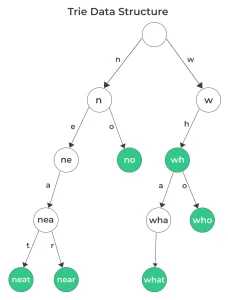Trie in Python

Introduction to Trie in Python
Trie in Python is a powerful data structure used for storing a dynamic set of strings where keys share common prefixes. It allows for fast insertion, deletion, and lookup operations, making it ideal for tasks like autocomplete and spell checking. With its hierarchical structure, Trie efficiently organizes words by their characters for optimal performance.
In this article, we will delve into the world of Trie in Python, exploring their structure, applications, and how to implement them
What is trie?
- Trie are tree-like data structures that are particularly useful for solving problems related to strings and text.
- The name “Trie” comes from the word “retrieval” because these structures excel at retrieving data associated with a specific key or prefix.
- Tries are prominently used in various applications, such as autocomplete systems, spell checkers, and IP routing tables.
Basic Trie Structure
- A Trie consists of nodes, where each node represents a character in a word or string. These nodes are connected in a hierarchical manner, forming a tree-like structure.
- The root node represents an empty string, and as you traverse down the Trie, you build words character by character.

Trie Operations
Implementation Of Trie in Python
let’s see how we can implement a Trie in Python. We will create a basic Trie structure and demonstrate insertion and search operations.
class TrieNode:
def __init__(self):
self.children = {}
self.is_end_of_word = False
class Trie:
def __init__(self):
self.root = TrieNode()
def insert(self, word):
node = self.root
for char in word:
if char not in node.children:
node.children[char] = TrieNode()
node = node.children[char]
node.is_end_of_word = True
def search(self, word):
node = self.root
for char in word:
if char not in node.children:
return False
node = node.children[char]
return node.is_end_of_word
Advantages of Trie in Python
Tries in Python offer several advantages:
Learn DSA
Prime Course Trailer
Related Banners
Get PrepInsta Prime & get Access to all 200+ courses offered by PrepInsta in One Subscription
Python trie library
- To get started, you’ll need to install the pytrie library if you haven’t already. You can install it using pip:
pip install pytrie
- Once you have pytrie installed, you can use it to create and manipulate trie data structures. Here’s a basic example of how to use it:
from pytrie import StringTrie
# Create a trie
trie = StringTrie()
# Insert keys into the trie
trie["apple"] = 1
trie["app"] = 2
trie["banana"] = 3
trie["bat"] = 4
# Check if a key exists in the trie
print("Is 'apple' in trie?", "apple" in trie) # True
print("Is 'apricot' in trie?", "apricot" in trie) # False
# Retrieve values associated with keys
print("Value of 'apple':", trie.get("apple")) # 1
print("Value of 'app':", trie.get("app")) # 2
# Find keys with a common prefix
print("Keys with prefix 'ap':", list(trie.keys(prefix="ap"))) # ['app', 'apple']
print("Keys with prefix 'ba':", list(trie.keys(prefix="ba"))) # ['banana', 'bat']
# Delete a key from the trie
del trie["apple"]
print("Is 'apple' in trie after deletion?", "apple" in trie) # False
- In this example, we create a StringTrie, insert keys with associated values, and perform various operations like checking for key existence, retrieving values, and finding keys with common prefixes.
The pytrie library is a convenient tool for working with trie data structures in Python, making it easier to implement tasks like autocompletion, searching for words with common prefixes, and more.
Python trie dictionary
- A Python Trie Dictionary, often referred to as a TrieMap or TrieDict, is a data structure that combines the characteristics of a trie and a dictionary (or hashmap).
- It allows you to efficiently store key-value pairs, where the keys are strings, and provides fast retrieval and insertion of these pairs.
Here’s an example of how to implement a simple Trie Dictionary in Python:
class TrieNode:
def __init__(self):
self.children = {}
self.value = None
class TrieDictionary:
def __init__(self):
self.root = TrieNode()
def insert(self, key, value):
node = self.root
for char in key:
if char not in node.children:
node.children[char] = TrieNode()
node = node.children[char]
node.value = value
def search(self, key):
node = self.root
for char in key:
if char not in node.children:
return None
node = node.children[char]
return node.value
def starts_with_prefix(self, prefix):
node = self.root
for char in prefix:
if char not in node.children:
return False
node = node.children[char]
return True
def delete(self, key):
def _delete(node, key, depth):
if depth == len(key):
if node.value is not None:
node.value = None
return len(node.children) == 0
return False
char = key[depth]
if char not in node.children:
return False
should_delete_child = _delete(node.children[char], key, depth + 1)
if should_delete_child:
del node.children[char]
return len(node.children) == 0
return False
_delete(self.root, key, 0)
# Example usage:
trie_dict = TrieDictionary()
trie_dict.insert("apple", 42)
trie_dict.insert("banana", 17)
print("Search 'apple':", trie_dict.search("apple")) # Output: 42
print("Search 'banana':", trie_dict.search("banana")) # Output: 17
print("Search 'cherry':", trie_dict.search("cherry")) # Output: None
print("Starts with prefix 'app':", trie_dict.starts_with_prefix("app")) # Output: True
trie_dict.delete("apple")
print("Search 'apple' after deletion:", trie_dict.search("apple")) # Output: None
| Aspect | Trie | HashTable |
|---|---|---|
| Data Retrieval Speed | O(K) for lookup, where K is key length | O(1) average-case lookup (with possible collisions) |
| Memory Usage | Can be memory-intensive, especially with common prefixes | Generally memory-efficient, except with many collisions |
| Prefix-Based Operations | Ideal for prefix-based operations like autocomplete | Not designed for prefix-based operations |
| Key Types | Primarily for string keys | Can handle various key types (integers, strings, custom objects) |
Use Cases of Tries in Python
- Autocomplete and Suggestions: Tries are commonly used in search engines, text editors, and applications that require autocomplete or suggestions. As a user types a query, a trie can quickly retrieve a list of matching words or phrases, making the user experience more interactive and responsive.
- Spell Checkers: Tries can be employed to implement spell-checking algorithms. Each node in the trie represents a valid prefix or word, and the spell checker can traverse the trie to suggest corrections for misspelled words.
- Dictionary and Lexicon: Tries are an excellent choice for implementing dictionaries and lexicons. They can efficiently store and retrieve words, making them useful for word games, language processing, and language translation applications.
- IP Routing: In networking, tries can be used for IP address routing and packet forwarding. IP routing tables can be implemented using a trie data structure to efficiently determine the next-hop destination for a given IP address.
Conclusion
Trie in Python are a versatile and powerful data structure for handling string-related operations efficiently. Whether you’re building a spell checker, an autocomplete system, or dealing with text data in any way, Tries can be your go-to solution. Understanding the structure and applications of Tries is a valuable skill for any programmer.
FAQs
A Trie is a tree-like data structure used to efficiently store and retrieve strings, especially useful for prefix-based searches. It is commonly used in autocomplete systems, dictionaries, and spell-checking.
While a dictionary offers O(1) lookup for whole keys, a Trie enables efficient prefix searching and storage of strings with shared prefixes, saving memory and time for large datasets.
To insert, iterate over each character of the word and create nodes if they don’t exist; mark the end of the word with a special flag. This ensures all prefixes are stored properly for future lookup.
Yes, Tries support both full word search and prefix search by traversing the tree nodes. This makes them ideal for tasks like autocomplete or word validation from large dictionaries.
Get over 200+ course One Subscription
Courses like AI/ML, Cloud Computing, Ethical Hacking, C, C++, Java, Python, DSA (All Languages), Competitive Coding (All Languages), TCS, Infosys, Wipro, Amazon, DBMS, SQL and others




Login/Signup to comment